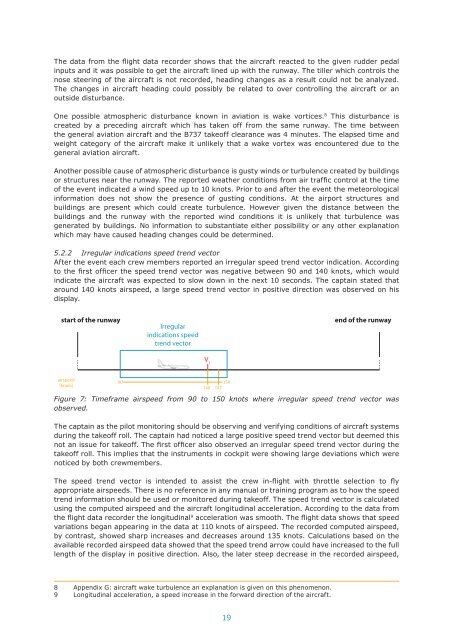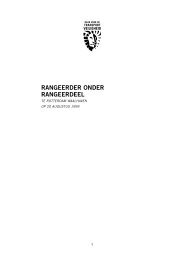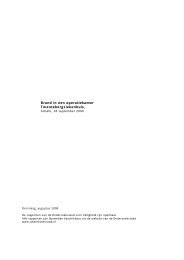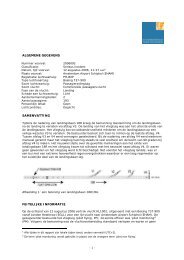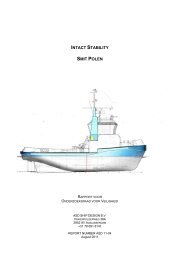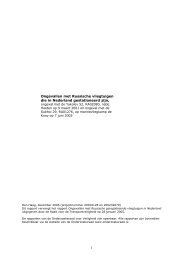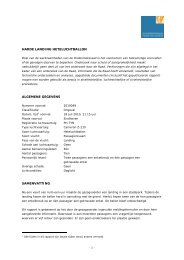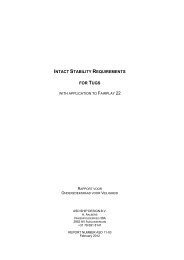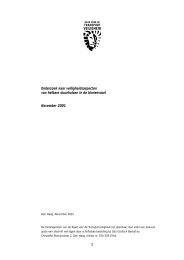Rejected takeoff after the takeoff decision speed 'V ', Boeing B737 ...
Rejected takeoff after the takeoff decision speed 'V ', Boeing B737 ...
Rejected takeoff after the takeoff decision speed 'V ', Boeing B737 ...
Create successful ePaper yourself
Turn your PDF publications into a flip-book with our unique Google optimized e-Paper software.
The data from <strong>the</strong> flight data recorder shows that <strong>the</strong> aircraft reacted to <strong>the</strong> given rudder pedal<br />
inputs and it was possible to get <strong>the</strong> aircraft lined up with <strong>the</strong> runway. The tiller which controls <strong>the</strong><br />
nose steering of <strong>the</strong> aircraft is not recorded, heading changes as a result could not be analyzed.<br />
The changes in aircraft heading could possibly be related to over controlling <strong>the</strong> aircraft or an<br />
outside disturbance.<br />
One possible atmospheric disturbance known in aviation is wake vortices. 8 This disturbance is<br />
created<br />
start of<br />
by<br />
<strong>the</strong><br />
a<br />
runway<br />
preceding aircraft which has taken off from <strong>the</strong> same runway. The<br />
end of<br />
time<br />
<strong>the</strong> runway<br />
Irregular<br />
between<br />
<strong>the</strong> general start aviation of aircraft indications and <strong>the</strong> <strong>speed</strong> <strong>B737</strong> <strong>takeoff</strong> aircraft clearance was 4 minutes. The elapsed time and<br />
weight category <strong>takeoff</strong> rollof <strong>the</strong> aircraft trend make vector it unlikely rotation that a rejected wake vortex <strong>takeoff</strong> roll was encountered due to <strong>the</strong><br />
general aviation aircraft.<br />
V 1<br />
Ano<strong>the</strong>r possible cause of atmospheric disturbance is gusty winds or turbulence created by buildings<br />
air<strong>speed</strong><br />
or structures 0 near 90 <strong>the</strong> runway. The reported wea<strong>the</strong>r 150 160 conditions from air traffic 0 control at <strong>the</strong> time<br />
[knots]<br />
60 80<br />
140 147 152<br />
of <strong>the</strong> event indicated a wind <strong>speed</strong> up to 10 knots. Prior to and <strong>after</strong> <strong>the</strong> event <strong>the</strong> meteorological<br />
information does not show <strong>the</strong> presence of gusting conditions. At <strong>the</strong> airport structures and<br />
buildings are present which could create turbulence. However given <strong>the</strong> distance between <strong>the</strong><br />
buildings start of <strong>the</strong> and runway <strong>the</strong> runway with <strong>the</strong> reported wind conditions it is unlikely that end turbulence of <strong>the</strong> runway was<br />
generated by buildings. No information to substantiate ei<strong>the</strong>r possibility or any o<strong>the</strong>r explanation<br />
which may start have of caused heading changes could be determined.<br />
<strong>takeoff</strong> roll<br />
5.2.2 Irregular indications <strong>speed</strong> trend vector<br />
After <strong>the</strong> event each crew members reported an irregular <strong>speed</strong> trend vector indication. According<br />
to <strong>the</strong> first officer <strong>the</strong> <strong>speed</strong> trend vector was negative between 90 and 140 knots, which would<br />
air<strong>speed</strong><br />
indicate 0 <strong>the</strong> aircraft 90 was expected to slow down in <strong>the</strong> next 10 seconds. The captain stated that<br />
[knots]<br />
60 80<br />
around 140 knots air<strong>speed</strong>, a large <strong>speed</strong> trend vector in positive direction was observed on his<br />
display.<br />
start of <strong>the</strong> runway<br />
Irregular<br />
indications <strong>speed</strong><br />
trend vector<br />
end of <strong>the</strong> runway<br />
V 1<br />
150<br />
air<strong>speed</strong><br />
[knots]<br />
90<br />
Figure 7: Timeframe air<strong>speed</strong> from 90 to 150 knots where irregular <strong>speed</strong> trend vector was<br />
observed.<br />
start of <strong>the</strong> runway<br />
end of <strong>the</strong> runway<br />
The captain as <strong>the</strong> pilot monitoring should be observing and verifying conditions of aircraft systems<br />
aircraft<br />
during <strong>the</strong> <strong>takeoff</strong> roll. The captain had noticed a<br />
rotation<br />
large positive <strong>speed</strong> trend vector but deemed this<br />
not an issue for <strong>takeoff</strong>. The first officer also observed an irregular <strong>speed</strong> trend vector during <strong>the</strong><br />
<strong>takeoff</strong> roll. This implies that <strong>the</strong> instruments in cockpit were showing large deviations which were<br />
noticed by both crewmembers.<br />
air<strong>speed</strong><br />
[knots]<br />
140 147<br />
150 160<br />
152<br />
The <strong>speed</strong> trend vector is intended to assist <strong>the</strong> crew in-flight with throttle selection to fly<br />
appropriate air<strong>speed</strong>s. There is no reference in any manual or training program as to how <strong>the</strong> <strong>speed</strong><br />
trend information should be used or monitored during <strong>takeoff</strong>. The <strong>speed</strong> trend vector is calculated<br />
using<br />
start<br />
<strong>the</strong><br />
of <strong>the</strong><br />
computed<br />
runway<br />
air<strong>speed</strong> and <strong>the</strong> aircraft longitudinal acceleration. According<br />
end<br />
to<br />
of<br />
<strong>the</strong><br />
<strong>the</strong><br />
data<br />
runway<br />
from<br />
<strong>the</strong> flight data recorder <strong>the</strong> longitudinal 9 acceleration was smooth. The flight data shows that <strong>speed</strong><br />
variations began appearing in <strong>the</strong> data at 110 knots of air<strong>speed</strong>. The recorded computed air<strong>speed</strong>,<br />
by contrast, showed sharp increases and decreases around<br />
rejected<br />
135<br />
<strong>takeoff</strong><br />
knots.<br />
roll<br />
Calculations based on <strong>the</strong><br />
available recorded air<strong>speed</strong> data showed that <strong>the</strong> <strong>speed</strong> trend arrow could have increased to <strong>the</strong> full<br />
length of <strong>the</strong> display in positive direction. Also, <strong>the</strong> later steep decrease in <strong>the</strong> recorded air<strong>speed</strong>,<br />
air<strong>speed</strong><br />
[knots]<br />
160 0<br />
8 Appendix G: aircraft wake turbulence an explanation is given on this phenomenon.<br />
9 Longitudinal acceleration, a <strong>speed</strong> increase in <strong>the</strong> forward direction of <strong>the</strong> aircraft.<br />
19


